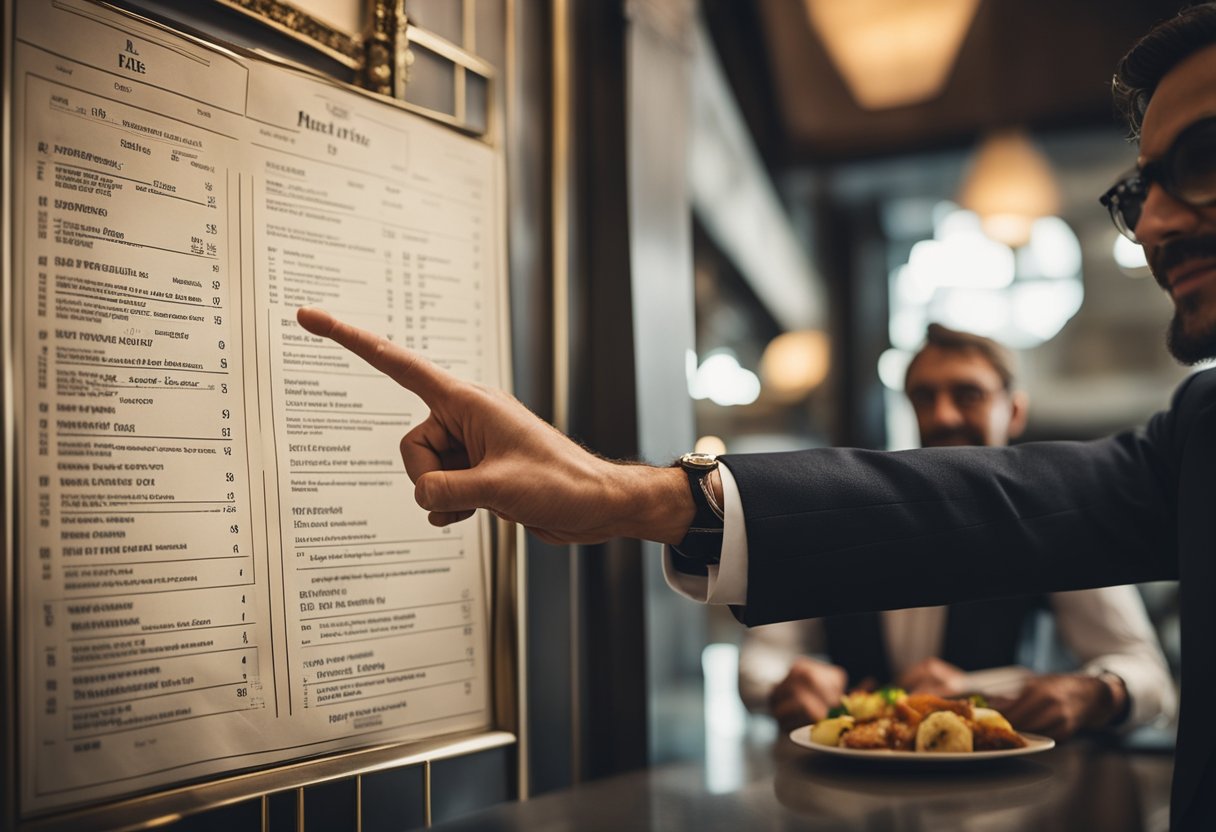How to Order in Italian: A Simple Guide for Dining Out
Ordering food at an Italian restaurant can be a delightful experience that extends beyond savoring the cuisine.
To navigate the process smoothly, a basic understanding of Italian dining etiquette and common phrases used in ristorantes and pizzerias across Italy is essential.
Learning how to effectively communicate your dining preferences ensures a more authentic and enjoyable meal.
From making reservations to understanding the menu and interacting with the staff, knowing the ins and outs of Italian dining culture is invaluable.

Understanding the structure of Italian menus is the first step to a successful meal in Italy or at an authentic Italian eatery elsewhere.
Menus typically offer a variety of courses with selections that may be unfamiliar to those not well-acquainted with Italian cuisine.
Acquiring a set of essential Italian phrases equips diners to place orders confidently, inquire about specials, and express dietary restrictions or allergies.
Being able to converse with waitstaff in their native language not only enhances the dining experience but also exhibits respect for the culture.
Key Takeaways
- Understanding Italian dining norms and phrases enhances the restaurant experience.
- Familiarity with menu structures and essential vocabulary aids in ordering.
- Effective communication with restaurant staff reflects cultural respect.
Making Reservations
https://www.youtube.com/watch?v=n3-juX_bWGA&embed=true
Reserving a table is a critical step in planning a dining experience in Italy.
This ensures a spot at the preferred venue and prevents inconvenience upon arrival.
Choosing the Venue
One must consider the type of dining experience desired before making a reservation.
In Italy, one can choose from a traditional ristorante for a full-service meal, a trattoria offering a more casual atmosphere, a tavola calda for ready-made hot dishes usually served at a counter, a pizzeria for a variety of pizzas, or an Italian bar for light fare and coffee.
- Ristorante: A formal venue suitable for a sit-down meal with multiple courses.
- Trattoria: A less formal establishment offering a homely ambiance.
- Tavola Calda: Ideal for a quick, budget-friendly meal.
- Pizzeria: Specialized in pizza, often with the addition of other simple dishes.
- Italian Bar: Great for a quick coffee, pastry, or aperitivo.
Booking Your Table
After selecting the dining establishment, reserving a table, colloquially referred to as “un tavolo,” is a straightforward process.
Patrons should contact the restaurant directly via phone or, at many establishments, use an online reservation system if available.
When booking, one should provide the party’s size, the desired date and time, and any special requests or dietary restrictions.
- Phone Reservation: Call during business hours and speak directly with staff.
- Online Reservation: Use the establishment’s online booking system if available.
- Details to Provide: Number of guests, reservation date and time, special requirements.
It is advisable to make reservations well in advance, especially for popular restaurants or during peak dining hours.
Understanding Italian Menus
https://www.youtube.com/watch?v=f78DK0MZfME&embed=true
Navigating Italian menus requires understanding their structure and common offerings to make informed choices.
Types of Menus
Italian restaurants may feature different types of menus, such as à la carte, where guests select individually priced dishes, or table d’hôte, which offers a set meal at a fixed price.
Some establishments might also present a degustation menu, offering a series of small tasting portions of their signature dishes.
Common Menu Categories
Menus in Italian restaurants are typically divided into several categories, each representing a course of the traditional Italian meal:
- Antipasto (Appetizer): A selection of small dishes to stimulate the appetite, often including cured meats, cheeses, and olives.
- Primi: The first main course, consisting of pasta, risotto, soup, or similar dishes.
- Secondi: The second main course, offering a choice of meat, fish, or vegetarian options, usually served without sides.
- Contorni: Side dishes that commonly accompany the secondi, including salads, potatoes, or vegetables.
- Dolci: Dessert items like gelato, tiramisu, or fruit.
Identifying Traditional Dishes
To fully experience an Italian meal, it’s helpful to know some traditional dishes by name:
| Course | Examples |
|---|---|
| Antipasto | Bruschetta, prosciutto e melone |
| Primi | Spaghetti carbonara, risotto al tartufo |
| Secondi | Osso buco alla Milanese (meat), branzino al sale (fish) |
| Contorni | Caponata (vegetarian), patate al forno (baked potatoes) |
| Dolci | Panna cotta, gelato alla nocciola (hazelnut ice cream) |
Dishes such as pizza may also feature on the menu outside these standard categories.
It’s essential for diners to understand these components to create a balanced and fulfilling Italian meal.
Essential Vocabulary for Ordering
https://www.youtube.com/watch?v=rEsiMG6yaZU&embed=true
When ordering in Italian, it’s helpful to know specific phrases and words that can clearly convey one’s preferences, dietary restrictions, and interest in local recommendations.
Mastery of these terms enhances the dining experience and ensures clear communication with the staff.
Common Phrases and Requests
The foundation of ordering in Italian involves a handful of common phrases:
- Vorrei… – “I would like…”
- Posso avere… – “Can I have…”
- Potrei vedere il menu, per favore? – “Could I see the menu, please?”
- Un tavolo per [numero], per favore. – “A table for [number], please.”
To order drinks, one might say:
- Vorrei un bicchiere di vino. – “I would like a glass of wine.”
- Un’acqua naturale/frizzante, per favore. – “A still/sparkling water, please.”
- Una birra, per favore. – “A beer, please.”
- Potrei avere un caffè/espresso/cappuccino, per favore? – “Could I have a coffee/espresso/cappuccino, please?”
For payment:
- Il conto, per favore. – “The bill, please.”
- Posso pagare con carta? – “Can I pay with a card?”
Describing Preferences and Dietary Restrictions
One should be clear about their dietary preferences and restrictions:
| Preferences/Restrictions | Italian Phrase |
|---|---|
| Vegetarian | Sono vegetariano/vegetariana. |
| Non-dairy | Senza latticini. |
| Gluten-free | Senza glutine. |
| Spicy | Piccante. |
| Non-spicy | Non piccante. |
To express preferences, one can say:
- Preferirei qualcosa di meno piccante. – “I would prefer something less spicy.”
- Avete opzioni vegetariane? – “Do you have any vegetarian options?”
Asking About Recommendations
To engage with the local cuisine and discover the restaurant’s specialties:
- Cosa consiglia? – “What do you recommend?”
- Qual è la specialità della casa? – “What’s the house specialty?”
- Mi può suggerire un vino locale? – “Can you suggest a local wine?”
One can show enthusiasm for recommendations by saying:
- Vorrei provare un piatto tipico. – “I would like to try a typical dish.”
- Qual è il vostro miglior piatto? – “What is your best dish?”
Placing Your Order
https://www.youtube.com/watch?v=OUyoW2_YRjw&embed=true
When entering an Italian restaurant, it is important to know the proper sequence in which to order the courses, from appetizers to desserts.
Ordering Appetizers
Italian meals typically begin with antipasti, or appetizers.
They are known as the first course and set the stage for the meal to come.
Patrons should consider ordering:
- Bruschetta: Grilled bread rubbed with garlic and topped with fresh tomatoes.
- Olive all’ascolana: Fried olives that are stuffed with meats and cheese.
These starters are often shared and can be paired with still water or sparkling water to cleanse the palate.
Selecting Main Courses
The second course is the heart of the Italian dining experience, often involving pasta or pizza.
Diners may choose from options like:
- Pasta Carbonara: Pasta with a creamy egg sauce, pancetta, and Parmesan.
- Margherita Pizza: A simple pizza with tomato, mozzarella, basil, and extra virgin olive oil.
For those looking for something lighter, salads or soups might be available.
It is customary to pair these dishes with a house wine that complements the flavors.
Choosing Drinks
Drinks are an integral part of the Italian meal. Whether ordering with the meal or waiting until afterwards, here are common selections:
- Italian Wine: Options often include reds like Chianti or whites such as Pinot Grigio.
- House wines are typically a reliable and cost-effective choice.
- Beer: A selection of local Italian beers may be available.
- Italian Coffee: Typically enjoyed after the meal, including espresso or cappuccino.
It is suggested to ask the server for drink recommendations based on the dishes selected.
Ordering Desserts
Italian desserts provide a sweet end to the meal.
Patrons should consider indulging in:
- Gelato: Italian ice cream, known for its rich flavor and creamy texture.
- Tiramisu: A layered dessert with coffee-soaked ladyfinger biscuits and mascarpone cheese.
Enjoying an espresso with dessert is a customary practice in Italy.
During the Meal
https://www.youtube.com/watch?v=HW6nkMvejSA&embed=true
Ordering in Italian can be smooth if one is mindful of a few important aspects.
Properly interacting with staff, handling any issues, and asking for additional items require a blend of politeness and clarity.
Communicating with the Staff
When engaging with the cameriere (waiter), it’s important to address them politely.
Phrases like “Scusi, signore/signora” (Excuse me, sir/madam) go a long way.
It’s beneficial to know some Italian phrases, but many waiters understand basic English too.
Use simple, clear language to avoid confusion.
- To order a side dish: “Potrei avere un contorno di verdure, per favore?” (Could I have a vegetable side dish, please?)
- For more water in your glass: “Potrei avere più acqua nel bicchiere, per favore?” (Could I have more water in my glass, please?)
Handling Issues
Should a dish arrive not as expected, politely gain the waiter’s attention.
One can use phrases like “Mi scusi, questo piatto non è come l’avevo ordinato.” (Excuse me, this plate is not as I ordered it.)
- Incorrect order: Quietly and politely point out the issue.
- Dissatisfaction: Express specifically what is wrong; for example, if a dish is cold, one might say, “Mi dispiace, ma questo piatto è freddo.” (I’m sorry, but this dish is cold.)
Requesting Additional Items
Sometimes one might need an extra utensil or another glass.
It’s customary to ask the waiter rather than to get it oneself.
- For an extra plate: “Potremmo avere un piatto in più, per favore?” (Could we have an extra plate, please?)
- Requesting another glass: “Mi può portare un altro bicchiere, per favore?” (Could you bring me another glass, please?)
Concluding Your Meal

When dining in Italy, knowing how to gracefully conclude your dining experience is as essential as the meal itself.
This includes knowing how to request the bill, understanding the nuances of tipping etiquette, and the appropriate way to thank your hosts.
Requesting the Bill
In Italy, one usually has to ask for the bill as it’s rare for it to be brought without a request.
A guest can catch a server’s attention and say, “Il conto, per favore,” which means “The bill, please.”
They should remain patient, as it might take some time for the bill to be prepared.
It’s common for bills to be paid at the counter in an Italian bar if that’s where one has consumed their coffee, such as a caffè lungo or latte macchiato.
Understanding Tipping Etiquette
Italy does not have a tipping culture as ingrained as other countries.
It is not obligatory to tip, but it is appreciated for exceptional service.
Tipping is typically done by leaving a small amount extra, usually 5-10% of the total bill.
Customers should check the bill for a line item labeled “coperto,” which is a cover charge for bread and table service.
If a service charge is included, additional tipping is discretionary.
| Type of Establishment | Suggestion |
|---|---|
| Casual Dining | Rounding up to the nearest euro is sufficient. |
| Upscale Restaurant | 5-10% tip for excellent service, unless service is included. |
| Italian Bar | Small change for coffee or drink is appreciated. |
Saying Thanks and Goodbyes
Leaving a dining establishment in Italy with a simple “Grazie, arrivederci!” meaning “Thank you, goodbye!” is customary and considered polite.
In more formal settings or after enjoying a bottle of fine wine, offering a more personal thank you to the host or waitstaff can leave a lasting good impression.
A diner might also indulge in a caffè corretto, a coffee “corrected” with a shot of grappa or another spirit, as a final touch to their meal before departing.
Frequently Asked Questions

What are some common phrases for ordering food in Italian restaurants?
When ordering food in Italian restaurants, phrases like “Vorrei ordinare…” (I would like to order…), “Potrei avere…” (Could I have…), and “Mi può portare…” (Can you bring me…) are commonly used.
To request the menu, say “Il menu, per favore.”
What is the polite way to ask for a drink in Italian?
To politely ask for a drink, one could say “Potrei avere un bicchiere di [drink], per favore?” which translates to “Could I have a glass of [drink], please?”
Replace [drink] with your beverage choice.
What expressions should I use when ordering coffee in Italy?
When ordering coffee in Italy, specify your coffee choice clearly: a “caffè” for an espresso, a “caffè latte” for a milk coffee, or a “cappuccino.”
Add “per favore” at the end to be polite.
Can you explain how to request pasta dishes in Italian eateries?
To request pasta dishes, you start with “Vorrei la pasta…” and add the specific type of pasta or sauce.
For example, “Vorrei la pasta con il pesto” (I would like pasta with pesto).
In Italian dining etiquette, is it customary to say ‘please’ when placing an order?
Yes, adding “per favore” is a sign of good manners and is expected when placing an order in Italian.
It translates to “please” and is typically placed at the end of the request.
What is the appropriate way to indicate that I am ready to order when seated at an Italian restaurant?
To indicate readiness to order, catch the server’s attention with eye contact and a polite nod.
You can also say “Scusi, siamo pronti per ordinare” which means “Excuse me, we are ready to order.”